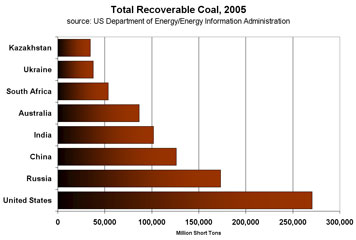Coal to oil conversion gaining interest in China, U.S.
Coal to oil conversion gaining interest in China, U.S.
Driven by surging oil prices, but fueling environmental concerns
mongabay.com
August 17, 2006
High oil prices are spawning greater interest in technologies that convert coal into liquid fuel, according to an article published yesterday in The Wall Street Journal, but the shift could have a significant impact on the environment.
Heightened tensions in the Middle East combined with booming demand and political instability in other regions have put a premium on crude oil and forced China and the United States — the world’s largest energy gluttons — to look towards secure sources of fuel. Both countries are coal-rich but petroleum-poor.
The Wall Street Journal says that China and the United States are actively developing coal-to-oil technology. China is building a multi-billion dollar coal-to-oil plant in Inner Mongolia and may be planning dozens more, while the U.S. Department of Defense is looking at coal-to-oil technology as a means to reduce dependence on foreign oil. The National Coal Council, an American pressure group, asking the government for subsidies that would help the domestic coal industry generate enough liquid fuel to satisfy 10 percent of America’s expected oil demand in 2025. Senators Barack Obama of Illinois and Jim Bunning of Kentucky have introduced bills calling for tax incentives for coal-to-liquid fuel conversion plants.
Despite the push, the Journal article says the benefits of the proposed shift are questionable.
“It’s far from clear… that the world would be better off — economically or environmentally — by burning more coal to fuel cars and trucks,” writes Patrick Barta, author of the article.
He notes that coal-to-oil plants are extremely expensive — “[a] single plant capable of producing about 80,000 barrels of oil equivalent a day — less than 0.5% of America’s daily oil diet — would cost an estimated $6 billion or more to build” — while there are serious environmental concerns about the process’s production of carbon dioxide, a greenhouse gas blamed for global warming, and other pollutants. Barta cites studies from the Natural Resources Defense Council, an American environmental group, that estimate the production and use of a gallon of liquid fuel originating from coal emits about 80 percent more carbon dioxide than the production and use of other fuels — gasoline, diesel fuel, jet fuel — derived from crude oil. Barta reports that “some boosters of the coal-to-oil plants describe them as carbon-dioxide factories that produce energy on the side” but that it may be possible to significantly reduce greenhouse-gas emissions by building new plants that use technologies to trap and store carbon dioxide during the production process.
The prospect of coal-to-oil conversion will add further to the already surging demand for the resource which now accounts for nearly 80 percent of electricity generation in China — up from 71 percent in 1990 — and 68 percent in India — up from 65 percent in 1990 — according to the World Bank. In the United States, where coal-fired power plants account for about 31 percent of the country’s carbon dioxide emissions, coal is the source for nearly 40 percent of electricity.
The growing use of coal energy source, combined with concerns over climate change, is fueling the push for cleaner ways to produce energy from coal. Even the chairman of Shell has called for green coal technologies to fight global warming.
RELATED ARTICLES
Shell chairman calls for clean coal technologies to fight global warming In a talk given last week at the prestigious Royal Society in Britain, the outgoing chairman of Shell Oil said that cleaner-burning coal technologies are urgently needed to minimize greenhouse gas emissions from the ongoing use of fossil fuels in coming decades.
Texas utility racing to build polluting coal-fired power plants
The Wall Street Journal (WSJ) today reported that TXU, a Dallas-based utility, is building 11 power plants that use pulverized coal. The paper notes that pulverized coal “releases substantial amounts of carbon dioxide, the most worrisome of several heat-trapping gases widely blamed for global warming.” The 11 new plants would more than double the company’s carbon-dioxide emissions, from 55 million tons in 2004 to more 133 million tons in 2011.
Clean coal could fight climate change A new chemical process for removing impurities from coal could lead to significant reductions in carbon dioxide emissions from coal-fired power stations say researchers sponsored by the Engineering and Physical Sciences Research Council, Britain’s main agency for funding research in engineering and the physical sciences.
Green coal? Process converts coal into diesel fuel As the United States’ oil reserves dwindle, some say the nation will have to rely on synthetic petroleum fuel made from its large stores of coal. A two-step chemical process augments a method of making cleaner-burning alternative fuel from coal and other carbon sources by transforming some of its waste products into diesel fuel, researchers from the University of North Carolina at Chapel Hill and Rutgers, the State University of New Jersey, report.
US has low-cost alternatives to oil; peak oil frenzy and human-induced climate change avoidable Surging oil prices have fueled calls for the United States to develop new sources of affordable and secure domestic energy. While renewable energy — especially biofuels, wind power, and solar technologies — is an area of particular interest, researchers from the Earth Institute at Columbia University say that the U.S. already has relatively low-cost alternatives to imported oil, including coal, tar sands, and oil shale. These resources can be extracted and used at a lower cost to the environment than some might expect.
This article used quotes from “South Africa Has a Way to Get More Oil: Make It From Coal”, an article by Patrick Barta which appeared in the August 16, 2006 issue of The Wall Street Journal.
